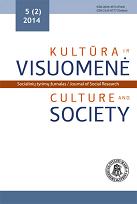Alkoholio vartojimo ir priklausomybės nuo alkoholio sąvokų apibrėžties problematika: socialinės dimensijos įtrauktiems aspektas
Defining concepts of the use of alcohol and alcohol dependence: the aspect of social inclusion
Author(s): Ilona TmutienėPublished by: Vytauto Didžiojo Universitetas
Keywords: Alkoholis; Intoksikacija; Vartojimas; Prisigėrimas; Alkoholizmas; Alkoholio vartojimo sutrikimas; Socialinė žala; Biomedicininė perspektyva; Socialinė dimensija Alcohol; intoxication; Binge drinking; Alcoholism; Alcohol use disorders; Social harm; Biomed
Summary/Abstract: Žalingas alkoholio vartojimas yra didelė socialinė problema, ypač Europoje. Kada alkoholio vartojimas pasidaro žalingas, kada išsivysto alkoholinė priklausomybė, yra pagrindinis tyrimo klausimas. Straipsnio tikslas – išanalizuoti alkoholio vartojimo ir priklausomybės nuo alkoholio nustatymo metodus, įvertinant šių metodų dėmesį socialinei dimensijai.1 Straipsnis remiasi literatūros analize. Alkoholio vartojimo apibrėžtys iš dalies siejamos su socialumo charakteristikomis (kultūrinis, socialinės integracijos vaidmuo), žala vartojančiajam ir aplinkiniams (rizikingas, probleminis, besaikis piktnaudžiavimas alkoholiu, alkoholizmas). Teoriniai alkoholio vartojimo debatai vyksta binarinėje perspektyvoje: saikingas – nesaikingas, rizikingas – nerizikingas, probleminis – neprobleminis, sveikas – nesveikas. Demarkacijos linija, skirianti priešingas pozicijas, nėra aiški. Tačiau alkoholio vartojimo apibrėžtyse vyrauja kiekybės matmuo, siejamas su išgerto alkoholio kiekiu. Nustatyta, kad pagrindiniai alkoholio vartojimo ir priklausomybės nuo alkoholio nustatymo metodai atstovauja biomedicininiam požiūriui, kai svarbiausias dėmesys skiriamas asmens psichofiziologinei sveikatai, o socialinė dimensija paliečiama tik fragmentiškai. Tokiame kontekste iškyla problema apibrėžiant priklausomybę kaip ligos procesą su priežastiniais mechanizmais ir socialinėmis pasekmėmis. Daug debatų ir vilčių sprendžiant šią problemą kilo Amerikos psichiatrų asociacijai aprobavus „Diagnostic and Statistical Manual of Mental Disorders-5“, kuriame panaikinta diagnostinė skirtis tarp piktnaudžiavimo alkoholiu ir priklausomybės nuo alkoholio. The harmful use of alcohol is an important social problem, especially in Europe. Focusing on the definitions and tools of evaluating the use of alcohol and alcohol dependence, the article asks when the use of alcohol can be characterised as harmful and when alcohol dependence begins. It also attempts to include social dimension into these definitions and to evaluate the assessment tools for the use of alcohol and alcohol dependence. The author related the definitions of the use of alcohol (heavy drinking, harmful use, hazardous use, problem drinking and excessive drinking, alcohol dependence or alcohol abuse) to such aspects of social context as the role of social integration and social harm due to the use of alcohol. The use of alcohol is often debated by drawing the binary combinations such as low risk vs. high risk drinking, problem vs. non–problem drinking, healthy vs. unhealthy drinking. The demarcation line between these opposites is rather unclear. While the use of alcohol is defined by qualitative methods based on the quantity of the alcohol used, the evaluation methods of the use of alcohol and alcohol dependence are associated with biomedical perspective that focuses on the person’s psychophysical health and almost omits social dimension.
Journal: Kultūra ir visuomenė: socialinių tyrimų žurnalas
- Issue Year: V/2014
- Issue No: 2
- Page Range: 178-201
- Page Count: 24

